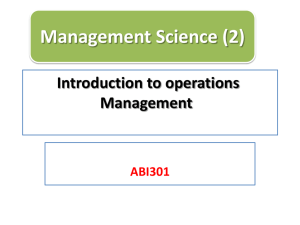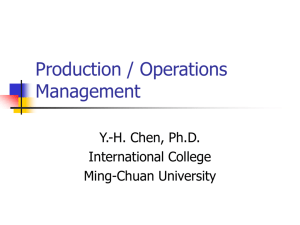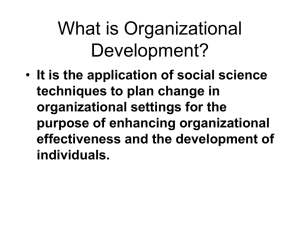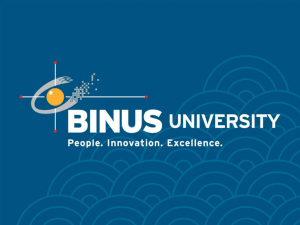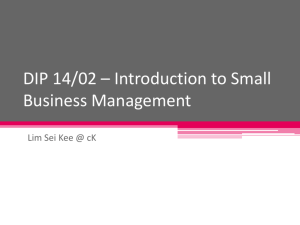Introduction
advertisement
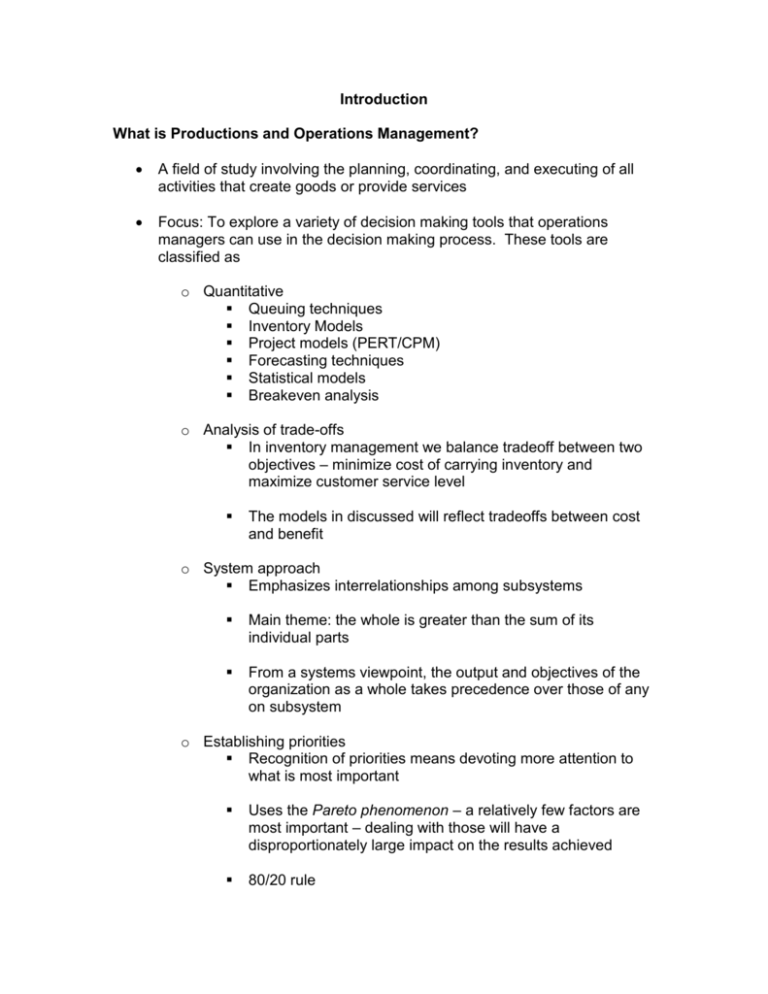
Introduction What is Productions and Operations Management? A field of study involving the planning, coordinating, and executing of all activities that create goods or provide services Focus: To explore a variety of decision making tools that operations managers can use in the decision making process. These tools are classified as o Quantitative Queuing techniques Inventory Models Project models (PERT/CPM) Forecasting techniques Statistical models Breakeven analysis o Analysis of trade-offs In inventory management we balance tradeoff between two objectives – minimize cost of carrying inventory and maximize customer service level The models in discussed will reflect tradeoffs between cost and benefit o System approach Emphasizes interrelationships among subsystems Main theme: the whole is greater than the sum of its individual parts From a systems viewpoint, the output and objectives of the organization as a whole takes precedence over those of any on subsystem o Establishing priorities Recognition of priorities means devoting more attention to what is most important Uses the Pareto phenomenon – a relatively few factors are most important – dealing with those will have a disproportionately large impact on the results achieved 80/20 rule o Ethics Operations managers, like all managers have the responsibility to make ethical decisions on: Worker safety, product safety, quality, the environment, the community, hiring and firing workers, worker’s rights Why study Operations Management (OM)? Operations management activities at the core of all business organizations 35% or more of all jobs are in OM related areas (customer service, quality assurance, production planning and control, scheduling, job design, inventory management, etc. Activities in all other areas of business organizations (finance, accounting, marketing, human resource, etc.) are interrelated with OM POM is all about management – all managers need to possess the knowledge and skill in the content areas in OM – learn and understand the variety of decision making tools in the decision making process A course that will prepare students in developing business plans (BA 499 –Business Planning is the capstone course for ALL business majors) Three Basic Functions of Business Organizations Finance, Production/operations, Marketing Marketing Production/ Operations Finance The operations function involves the creation of inputs into outputs Outputs Goods and Services Transformation/ conversion process Inputs Land Labor Capital Information Feedback Feedback Feedback Control Examples of Types of Operations Type of Operation Goods producing Examples Farming, mining, construction, manufacturing, power generation Storage/transportation Warehousing, trucking, mail service, moving, taxis, buses, hotel, airlines Exchange Retailing, wholesaling, banking, renting or leasing, library loans Entertainment Films, radio and TV, plays, concerts, recording Communication Newspapers, radio and TV newscast, telephone, satellite Illustrations of the Transformation Process Food Processing Hospital Inputs Processing Output Raw vegetables Metal sheets Water Energy Labor Building Equipment Cleaning Making cans Cutting Cooking Packing Labeling Canned vegetables Inputs Processing Output Doctors, nurses Hospitals Medical supplies Equipment Laboratories Examination Surgery Monitoring Medication Therapy Healthy patients Examples of inputs, transformation, and outputs Inputs Transformation Output Land Human Physical Intellectual Raw materials Energy Water Chemical Metals Wood Equipment Machines Computers Trucks Tools Facilities Hospitals Factories Offices Retail stores Other Information Time Processes Cutting, drilling Transporting Teaching Farming Mixing Packing Canning Consulting Copying, faxing Goods Houses Autos Clothing Computers Machines TVs Food products Textbooks Magazines Shoes Electronic items Services Health care Entertainment Car repair Delivery Gift wrapping Legal Banking Communication Production Good versus Service Operations Characteristics Goods Services Output Customer contact Uniformity of input Labor content Uniformity of output Measurement of productivity Opportunity to correct quality problems before delivery to customer Tangible Low High Low High Easy High Intangible High Low High Low Difficult Low Productivity, Competitiveness and Strategy Productivity – an index that measures outputs (goods or services) relative to the input Productivi ty Output Input Some Examples of Different Types of Productivity Measures Partial measures Output Labor Multifactor measures Output Labor Machine Total Measures Goods or Service Produced All inputs used to produce them Factors that Affect Productivity Methods Capital Quality Technology Management Output Machine Output Capital Output Energy Output Labor Capital Energy Strategy Has a long term impact on the nature and characteristics of the organization Affects the ability of an organization to compete, or in the case of a nonprofit organization, the ability to serve its intended purpose The nature of an organization’s strategy depends on its mission Mission The basis of the organization – the reason for its existence Mission statement Answers the question, “What business are we in?” Serves to guide formulation of strategies for the organization as well as the decision making at all levels Without it an organization is likely to achieve its true potential because there is little direction for formulating strategies Strategies and Tactics Strategies are plans for achieving goals Strategies provide focus Tactics are the methods and actions to accomplish strategies The “how to” part of the process Strategy Formulation – the formulation of an effective strategy must take into account: 1) distinctive competencies of the organization – this can be accomplished by doing a SWOT (strengths, weaknesses, opportunities, and threats) analysis price, quality, time, flexibility, service, location 2) scan the environment – the considering of events and trends that present either threat or opportunities External factors: economic condition, political condition, legal environment, technology, competition, markets Internal factors: Human resources, facilities and equipment, financial resources, customers, products and services, technology, suppliers

